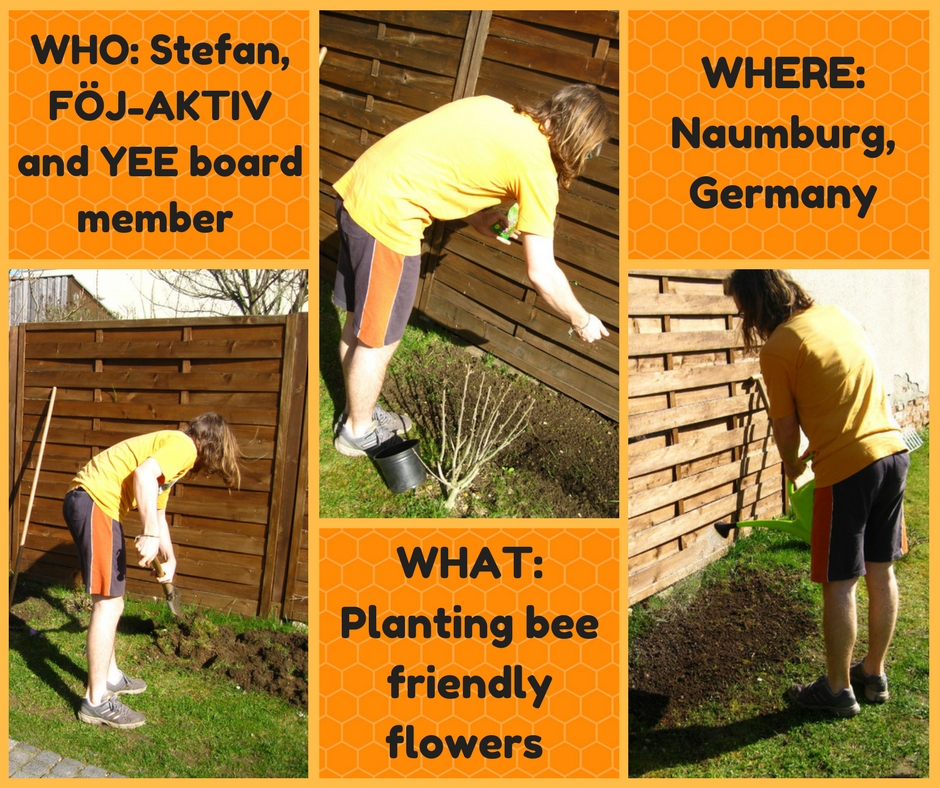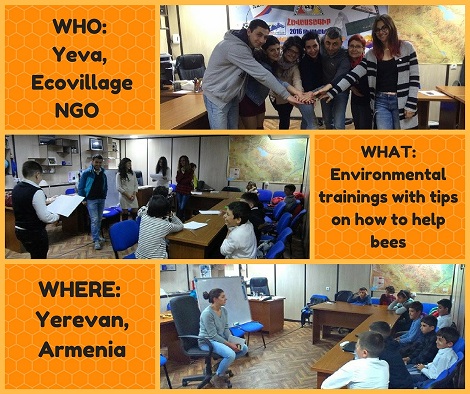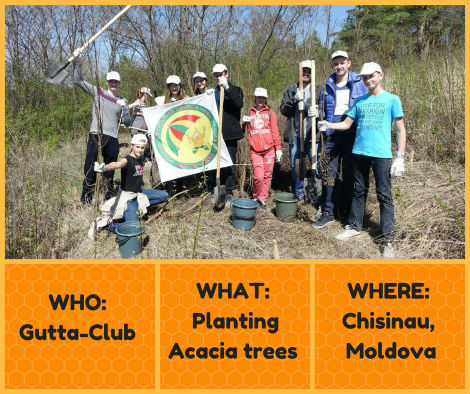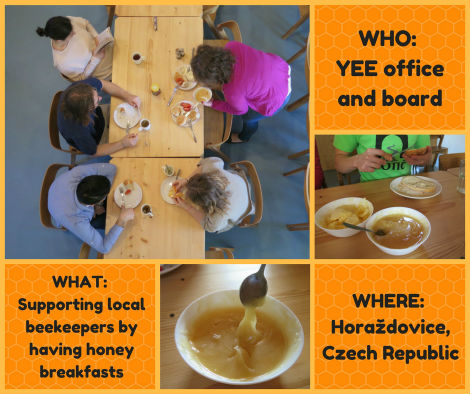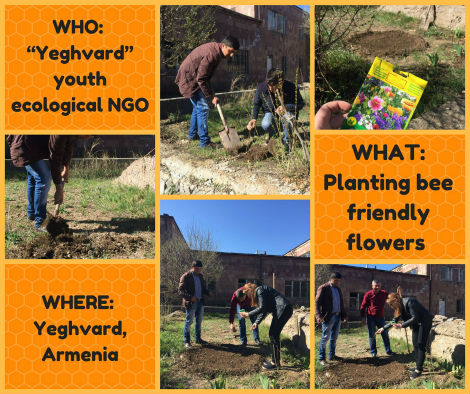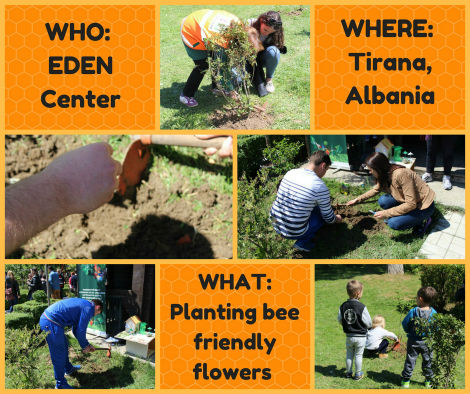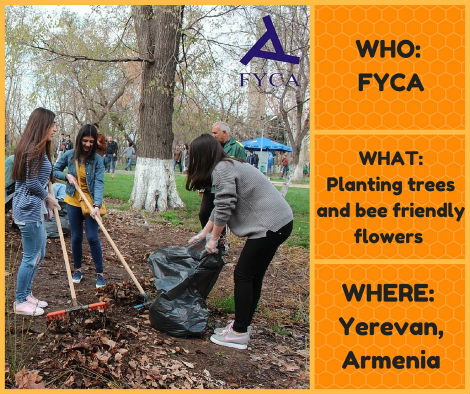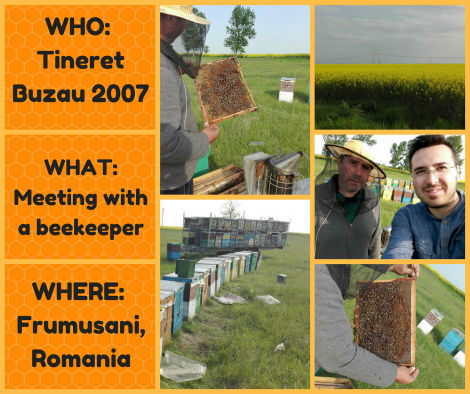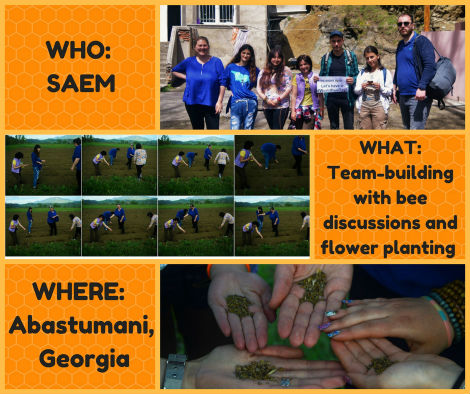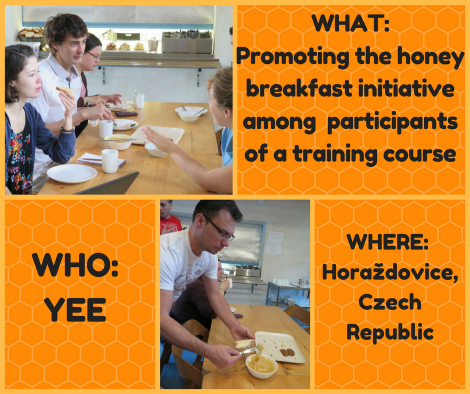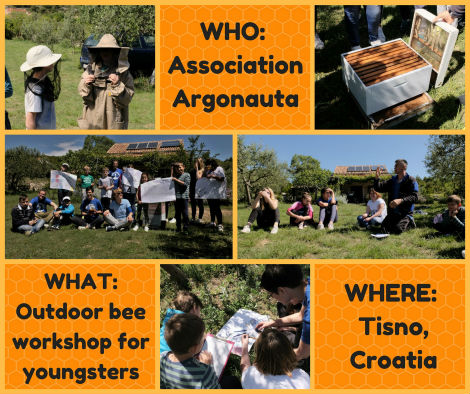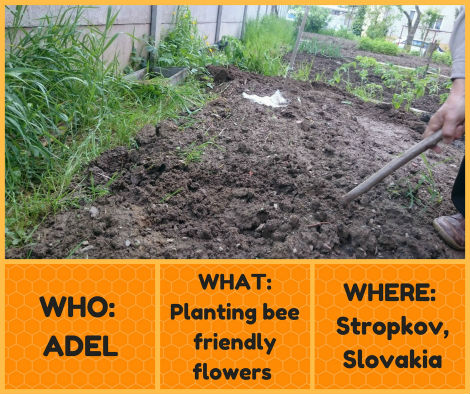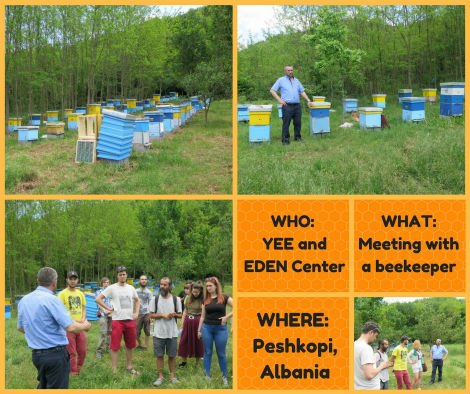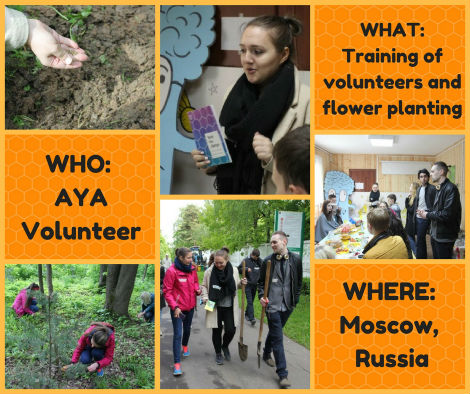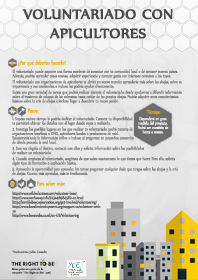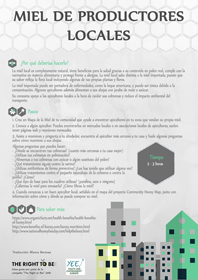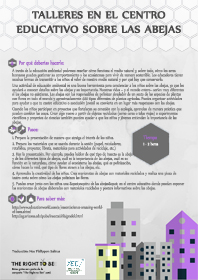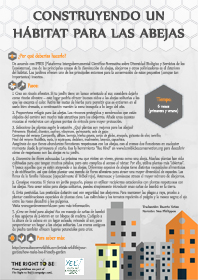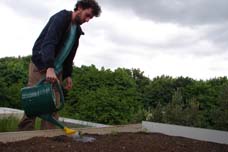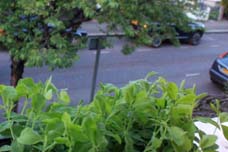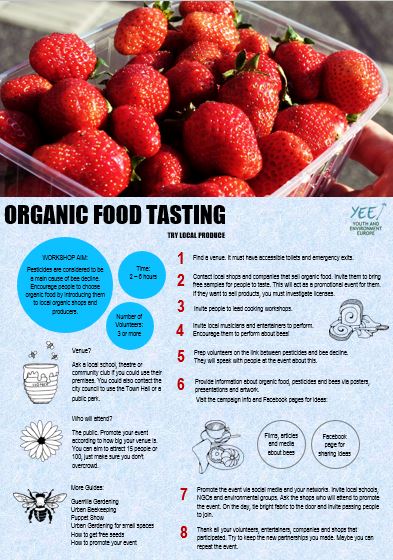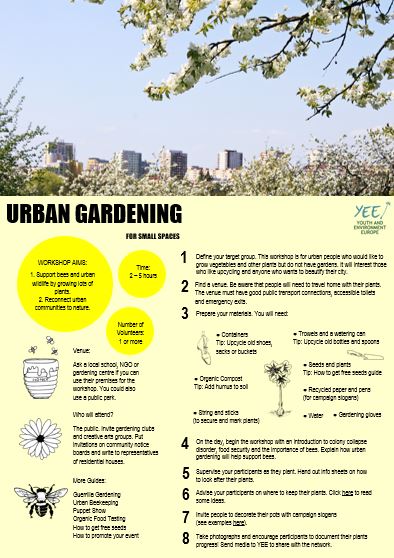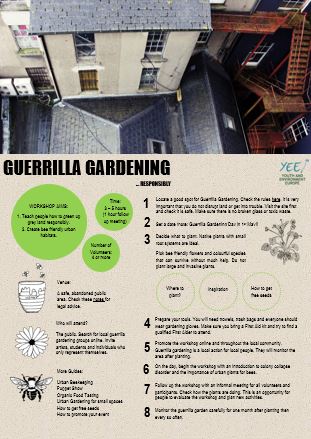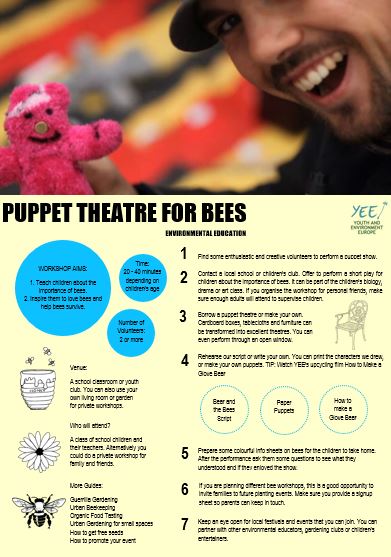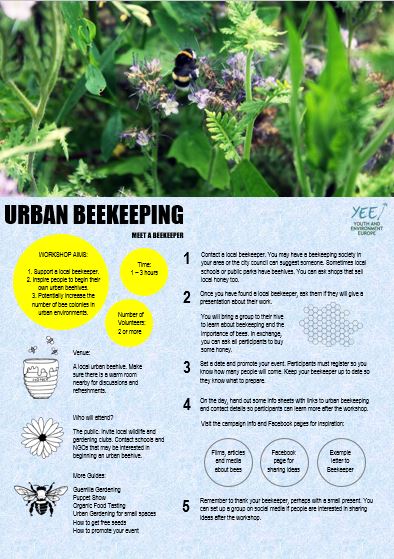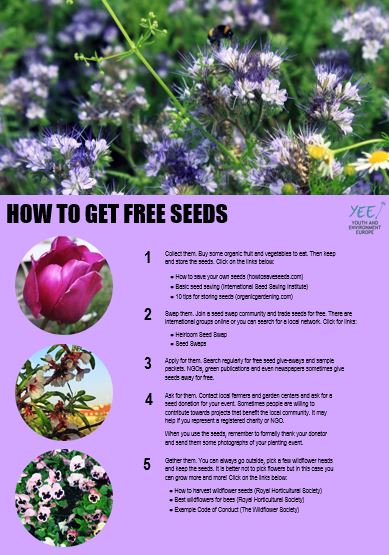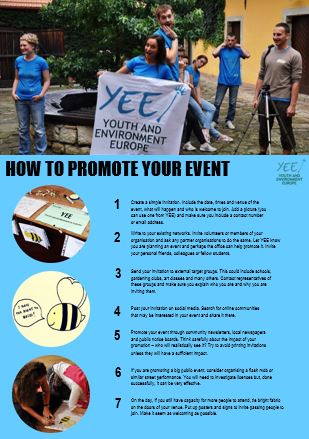Deprecated: Methods with the same name as their class will not be constructors in a future version of PHP; plgContentJw_allvideos has a deprecated constructor in /home/html/yeenet.eu/public_html/www/archives/plugins/content/jw_allvideos/jw_allvideos.php on line 18
Deprecated: implode(): Passing glue string after array is deprecated. Swap the parameters in /home/html/yeenet.eu/public_html/www/archives/plugins/content/jw_allvideos/jw_allvideos.php on line 72
Deprecated: implode(): Passing glue string after array is deprecated. Swap the parameters in /home/html/yeenet.eu/public_html/www/archives/plugins/content/jw_allvideos/jw_allvideos.php on line 72
Deprecated: implode(): Passing glue string after array is deprecated. Swap the parameters in /home/html/yeenet.eu/public_html/www/archives/plugins/content/jw_allvideos/jw_allvideos.php on line 72
Deprecated: implode(): Passing glue string after array is deprecated. Swap the parameters in /home/html/yeenet.eu/public_html/www/archives/plugins/content/jw_allvideos/jw_allvideos.php on line 72
Deprecated: implode(): Passing glue string after array is deprecated. Swap the parameters in /home/html/yeenet.eu/public_html/www/archives/plugins/content/jw_allvideos/jw_allvideos.php on line 72
Deprecated: implode(): Passing glue string after array is deprecated. Swap the parameters in /home/html/yeenet.eu/public_html/www/archives/plugins/content/jw_allvideos/jw_allvideos.php on line 72
Deprecated: implode(): Passing glue string after array is deprecated. Swap the parameters in /home/html/yeenet.eu/public_html/www/archives/plugins/content/jw_allvideos/jw_allvideos.php on line 72
Deprecated: implode(): Passing glue string after array is deprecated. Swap the parameters in /home/html/yeenet.eu/public_html/www/archives/plugins/content/jw_allvideos/jw_allvideos.php on line 72
Deprecated: implode(): Passing glue string after array is deprecated. Swap the parameters in /home/html/yeenet.eu/public_html/www/archives/plugins/content/jw_allvideos/jw_allvideos.php on line 72
Deprecated: implode(): Passing glue string after array is deprecated. Swap the parameters in /home/html/yeenet.eu/public_html/www/archives/plugins/content/jw_allvideos/jw_allvideos.php on line 72
Deprecated: implode(): Passing glue string after array is deprecated. Swap the parameters in /home/html/yeenet.eu/public_html/www/archives/plugins/content/jw_allvideos/jw_allvideos.php on line 72
Deprecated: Array and string offset access syntax with curly braces is deprecated in /home/html/yeenet.eu/public_html/www/archives/libraries/idna_convert/idna_convert.class.php on line 421
Deprecated: Array and string offset access syntax with curly braces is deprecated in /home/html/yeenet.eu/public_html/www/archives/libraries/idna_convert/idna_convert.class.php on line 435
Deprecated: Array and string offset access syntax with curly braces is deprecated in /home/html/yeenet.eu/public_html/www/archives/libraries/idna_convert/idna_convert.class.php on line 826
Deprecated: Array and string offset access syntax with curly braces is deprecated in /home/html/yeenet.eu/public_html/www/archives/libraries/idna_convert/idna_convert.class.php on line 957
Deprecated: implode(): Passing glue string after array is deprecated. Swap the parameters in /home/html/yeenet.eu/public_html/www/archives/plugins/content/jw_allvideos/jw_allvideos.php on line 72
Deprecated: implode(): Passing glue string after array is deprecated. Swap the parameters in /home/html/yeenet.eu/public_html/www/archives/plugins/content/jw_allvideos/jw_allvideos.php on line 72
Deprecated: implode(): Passing glue string after array is deprecated. Swap the parameters in /home/html/yeenet.eu/public_html/www/archives/plugins/content/jw_allvideos/jw_allvideos.php on line 72
Deprecated: implode(): Passing glue string after array is deprecated. Swap the parameters in /home/html/yeenet.eu/public_html/www/archives/plugins/content/jw_allvideos/jw_allvideos.php on line 72
Deprecated: implode(): Passing glue string after array is deprecated. Swap the parameters in /home/html/yeenet.eu/public_html/www/archives/plugins/content/jw_allvideos/jw_allvideos.php on line 72
Deprecated: implode(): Passing glue string after array is deprecated. Swap the parameters in /home/html/yeenet.eu/public_html/www/archives/plugins/content/jw_allvideos/jw_allvideos.php on line 72
Deprecated: implode(): Passing glue string after array is deprecated. Swap the parameters in /home/html/yeenet.eu/public_html/www/archives/plugins/content/jw_allvideos/jw_allvideos.php on line 72
Deprecated: implode(): Passing glue string after array is deprecated. Swap the parameters in /home/html/yeenet.eu/public_html/www/archives/plugins/content/jw_allvideos/jw_allvideos.php on line 72
Deprecated: implode(): Passing glue string after array is deprecated. Swap the parameters in /home/html/yeenet.eu/public_html/www/archives/plugins/content/jw_allvideos/jw_allvideos.php on line 72
Volunteers in YEE
"The Right to Be(e)" was a grassroots campaign which aimed to support the survival of bees with local actions. The first concern was to attract more attention to the disappearance and well-being of bees in Europe. The campaign was created in 2012, and the first actions started in 2013. It was open to everybody – bee enthusiasts or not – and encouraged anyone to help bees no matter how small the action was (planting a flower, visiting a local beekeeper…). Because all actions are a step for improving the well-being of bees, and, on the long run, our own well-being.
Here are the results of five years of campaigning for the bees!

NGOs, primary schools, groups of friends, families, but also people on their own took part in this campaign. We send a warm thank you to everybody for their involvement and their will to help bees!

The actions were very diverse and creative, individual and collective. Everyone who took part in this campaign contributed to raising awareness about the disappearance of bees and/or to bee-survival in Europe. Should it be by trying to learn more about bees and how to improve their well-being, by supporting and visiting local beekeepers, by providing information and triggering the collective reflection through workshops and online campaigns, or by creating a bee-friendlier environment (planting flowers, building bee hotels…).
Check out “The Right to Be(e)” actions map here.
Thanks to our participants, flowers, herbs, and fruits and vegetables have grown in gardens, balconies and urban areas. We mention some of them:
![]() Bell flowers, Royal purple brunfelsia, Calendula, Dahlia, Daisy, Sacred datura, Carnation, Fidelity, Forget-me-not, Blue tansy, Malva, Petunia, Marigold, Whitelady
Bell flowers, Royal purple brunfelsia, Calendula, Dahlia, Daisy, Sacred datura, Carnation, Fidelity, Forget-me-not, Blue tansy, Malva, Petunia, Marigold, Whitelady
![]()
Lavender, Chamomile, Melissa, Mentha, Basil, Oregano, Rosemary, Sage, Thyme
![]()
Cucumber, Eggplant, Strawberries, Sweet pea, Tomato, Zucchini
…Any many other species!

This campaign has been supported by 12 ‘bee campaigners’ across Europe (you can find their profiles in “The Right to Be(e)”’s Facebook album “Bee Campaigners”) and by 470 bee-lovers, who followed “The Right to Be(e)”’s Facebook page and received updates from the campaign as well as some useful information about bees.


The Right to Be(e) actions started one year after the beginning of the campaign, with an info and planting workshop organised by the YEE team in the eco-center Toulcuv Dvur (Prague, Czech Republic) during the Day of Earth, and a family planting in Walmsburg (Germany).

The summer of 2014 was a big step for the campaign, with the launch of the first The Right to Be(e) Competition. The competition aimed to foster the organisation of local workshops about bees in order to raise awareness about the disappearance of bees in Europe.
This workshop competition gathered 7 participants: the NGO gardening group “Vi Odlar!”, from Lund University (Sweden), the art space “MUDDUM” (Czech Republic), the organisation for eco-clubs “OPE” (Portugal), the youth center “SVČ” (Czech Republic), the youth organisation “Mine Vaganti” (Italy), the environmental organisation “Biodiversa” (Spain), and the youth organisation “GUTTA-CLUB” (Moldova).
The first place was awarded to “GUTTA-CLUB”, for the workshop “Save bees”, that aimed to inform and discuss about the importance of bees through different means (lecture, painting workshop, flash mob, theatre play…).
Hu2 Design kindly supported The Right to Be(e) by offering some amazing eco-friendly stickers as prizes for this competition. Find them on Facebook here.

This year was the planting year! The Right to Be(e) campaign focused on the promotion of grassroots planting actions all around Europe. Between 11th and 23rd of May, 12 participants from 8 different countries took part in this planting movement, to make our Earth a better place for the bees.

The summer of 2016 was very active! We counted 8 different actions (for example, visits to local beekeepers, workshops for children, debates, planting actions, online campaigns…), including our 5 participants of the third "The Right to Bee" competition that focused on helping bees in urban areas.
Participants in the competition were: the center for Development Education and Networking “EDEN” (Albania), Sombor elementary schools (Serbia), the Association for International Cooperation “EYAS” (Spain), Ylona Erard (France), the youth eco-movement “SAEM” (Georgia).
The winner was “EYAS”, for their creative Twitter campaign.
This year was also focused on learning. Between 23rd and 30th of August, YEE organised the training course (“Be(e) the change”) in the eco-center Toulcuv Dvur (Prague, Czech Republic), in order to improve YEE's and Member Organisations' campaigning skills by discovering more tools that make an educational environmental campaign successful.
One outcome of this training course was the booklet ‘Be(e) the change - guide on campaigning”, that helps you to start, to lead and to close a campaign. You can also find advice and useful information on how to help bees in the section “What you can do - Toolkit”.

During April and May, “The Right to Be(e)” campaign focused on sharing, action and support. This year again, organisations and people from all over Europe carried out diverse actions ranging from flower plantings and educational trainings, to meetings with beekeepers and fostering local beekeeping with a honey breakfast initiative.
Keep being involved in your community for improving the welfare of bees! Have a look at the section “What you can do - Toolkit” and check what you can do to help bees
Want to know more about the situation of bees nowadays? Check the section “Report about bees (2017)”.
|
|
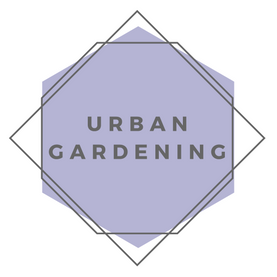 |
|
|
|
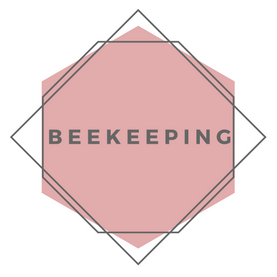 |
|
|
|
 |
|
Do you want to read about The Right to Be(e) campaign? Have a look at the section "Summary of results The Right to Be(e)".
If you are curious to know more about the current situation of bees, check the section “Report about bees (2017)”.

Bees are already up and about their business...and what are you up to?
Spring has been the perfect time for launching our "The Right to Be(e)" campaign. Like many years before, we again set out to attract more attention to the well-being of bees in Europe. "The Right to Be(e)" is a grassroots campaign which aims to support the survival of bees with local actions. It is open to everybody - no matter if you are a bee enthusiast or not. And in the end it is for everybody, not just bees. By helping them, we help ourselves on the long run.
In 2017 we focused on sharing, action and support. We carried out diverse actions, ranging from flower plantings (as a follow up to our Be(e) The Change training course) and educational trainings, to meetings with beekeepers and promotions of a honey breakfast initiative. Interested to learn more? Click the banner below!
Funders:
 |
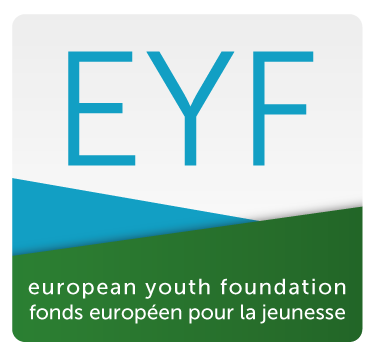 |
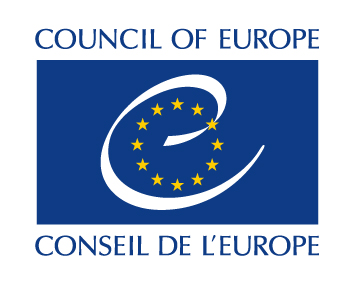 |
We prepared a few guidelines presenting examples of urban activities that you can make in order to help the bees. They are here only for your inspiration - feel free to try other ideas. Put your knowledge, creativity and concern for the bees to good use. :)
Text: Esther Vallado, Natalia Luchko, Judit Suveges, Vladimir Jordanov, Ruzanna Manyan, Jovana Mirjanić, Tijana Ljubenovic
Design: Roxana Nica
Activities guidelines available in Spanish language
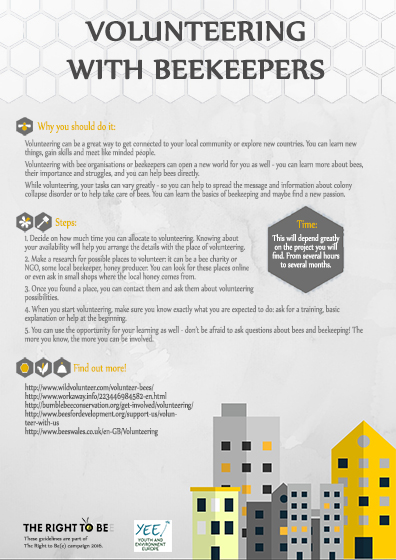 |
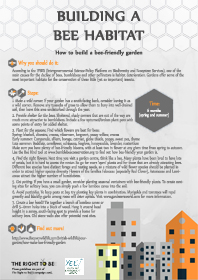 |
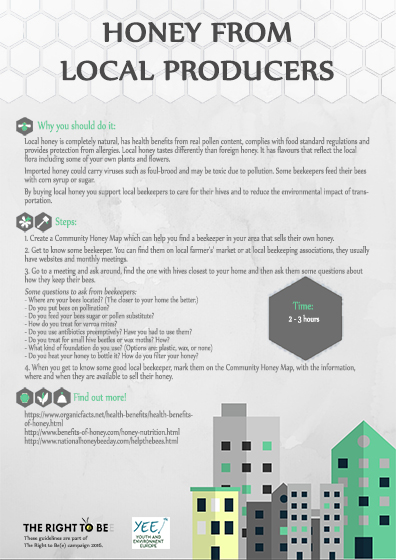 |
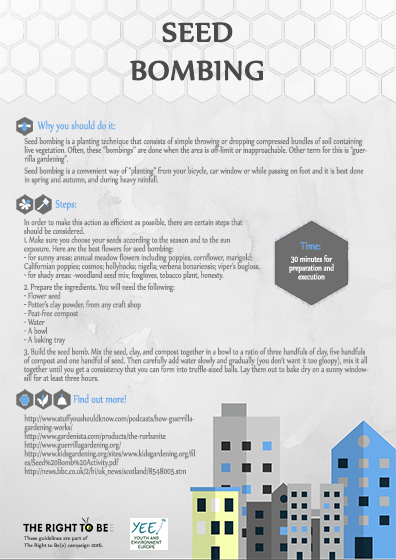 |
 |
 |
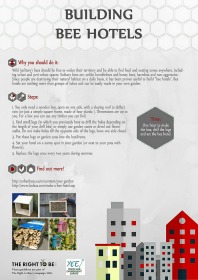 |
The Right to Be(e) competition for the best activity to help the bees is now closed. The winner was EYAS and their creative Twitter campaign to promote the importance of bees. All results are shown below. Congratulations to all participants!
Stay tuned for more bee activities!
ENTRY MODELS
Games about bees and planting action in Toulcuv Dvur
Who organised the activity: YEE office
When it took place: 22 April 2016
Where it took place: Toulcuv Dvur, Prague (Czech Republic)
What happened: On the Earth Day celebration YEE prepared a few activities for children. We had n ongoing workshop on making paper bees (which they could stick to flower pots), a game about the fruits and vegetables we can find in the garden that can be pollinated by bees, bee face painting. We also organised a planting action in the farm with the children through which we planted sunflower seeds and greenpea seeds.
Why do you want to help the bees: because they help us in so many ways and they contribute significantly to the health of our planet.
 |
 |
 |
Planting flowers in Macedonia
Who organised the activity: Vladimir Jordanov
When it took place: 17 May 2016
Where it took place: Stip, Macedonia
What happened: I planted a bee-friendly Gerbera Daisy flower in the garden of my house
Why do you want to help the bees: to have balanced and healthy ecosystems
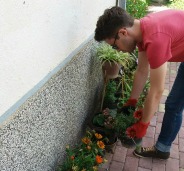 |
 |
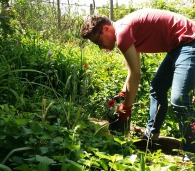 |
COMPETITION ENTRIES:
Planting flowers beside the trees on the city's sidewalk
Who organised the activity: EDEN Center
When it took place: 6 May 2016
Where it took place: Tirana, Albania
What happened: For the campaign we planted some flowers with the intention to increase the awareness regarding the bee issue by asking the interested ones to donate flowers to be planted beside the trees on the sidewalk as we did. Find out more here.
Why do you want to help the bees: we want to highlight the importance that the bees represent for the nature as well as humans; a reason why we are part on the campaign too.
 |
 |
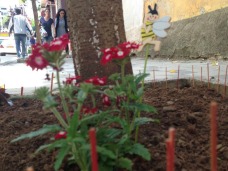 |
Actvities for the bees in Serbian elementary schools
Who organised the activity: Two elementary schools from Sombor, Serbia.
When it took place: 21 May 2016
Where it took place: It took place in our school, both in biology classroom and in school garden.
What happened: We talked about biodiversity and the importance of bees in human life and in nature in general. Also we talked about global problem-disappearing of bees, and thus to that we watched this video. After that we planted some flowering plants in our school garden. Also, we made few interesting magnets with bee, flower and hive motives that are now in our biology classroom, and in our homes.
Why do you want to help the bees: Importance of bees in life of all living creatures is enormous. They provide us food, they provide food to animals and reproduction to flowering plants. Without bees our life would be very different from this that we live now. So if we want to change nothing and to have various food in our plates, we need to help and protect the bees.
 |
 |
 |
Twitter campaign about the importance of bees
Who organised the activity: EYAS Young European Association for International Cooperation
When it took place: From 5th – 11th June 2016
Where it took place: Zaragoza and Madrid, Spain
What happened: We launched an online twitter campaign raising awareness about the protection of bees. It was a 7 days campaign, starting on the Environmental World Day (5thJune). We structured the campaign in 7 topics, answering with facts to these question:
Day 1: Why bees are so important?
Day 2: Why bees can disappear?
Day 3: Inspiring initiatives for the protection of bees
Day 4: What can we do for bees? Supporting this topic we planted 2 flower plants on the roofs of Madrid (photo)
Day 5: Let's share bee friendly workshop ideas
Day 6: Support your local community. Supporting this topic the team bought local honey in Zaragoza (photo)
Day 7: Spread the message!
The language used was Spanish. We reached 60 people and organizations directly, having likes and retweets JWe also mentioned organizations such @Greenpeace_Es @ONU_es and @UN to have more impact. The account for the campaign was @eyas_europe and the following hashtags were used: #RightToBee #salvemoslasabejas #SOSabejas #DMMA2016
Why do you want to help the bees: Because they balance nature and keep biodiversity.
 |
 |
 |
Having a bee-friendly garden with a wild corner
Who organized the activity? Ylona Erard
When it took place: 10th of June 2016
Where it took place: Drome, France
What happened: In the back of my garden, we have two beehives. This year I decided to let a part of the garden growing wild and it turned into beautiful wild flowers. They are really appreciated by bees and bumblebees that are buzzing all around.
Why do you want to help the bees? Because I am not sure people realize how important they are. How would be my garden without bees? How would be nature without bees?
 |
 |
|
Raising awareness on bees with online activities and meeting of beekeepers and strawberry farmers
Area Yvibisi and Daba, Georgia
We were inviting for participation every interested person to share with us their activities.They were supposed to take pictures and sent to us. We get very interesting photos from young people who shared with us their thoughts and experiences.
We visited village Kvibisi ,which is located near the Borjomi on 900 meters above sea level.There, we met one of the member of the Devidze family , they are 4-th generation beekeepers .There, in a clean environment, this family is following beekeeping and they are keeping about 100 beehives. As miss Marina told us : "Taking care of bees is a great art and consuming affair. In Devidze family, beekeeping is a tradition. My father had taught me the art of beekeeping and now I'm trying to teach it to young generations of my family and share my experience. The boys have accumulated considerable experience. Beekeeping is a practical affair and requires a lot of attention and experience gained through hard working. Scientists are often visiting us and they are completing their theoretical studies with exploring and observing our practical work. I will be happy if young people will be involved in this work and, for my part, I will share with them my experience .In my opinion in every village there should be one or two beekeeping family." Miss Marina gave us some helpful tips about beekeeping : about how important is to keep them in clean environment ,to avoid chemicals on fruits they use for food, to avoid feeding them with artificial food like sugar and etc. After rich informational conversation, we took some pictures and continued on our way to the next destination.
Near the woods is situated a cooperative of strawberry farms,where they are growing eco friendly ,clean and unpolluted strawberries and other kinds of berries. This farm was founded within United Nations Development Programme grant by Irma Maghradze .The project aims to strengthen the capacity of forest-dependent local communities, so that they can create and develop alternative livelihoods through the sustainable use of forest resources. The idea of strawberry farm was Irmas discovery, before this she had a little garden of strawberries next to her home, and she says that to be high level from the sea level is great for berries. That's why she decided to make a farm in this place.The local youngsters are actively involved in this project and they shared their impressions about thei work with excitement.
Miss Irma hosted us and shared her experience with Georgia Youth Eco Movement-SAEMs members. She invited us to see strawberry fields and she gave us to try bright red, perfectly shaped strawberries, She presented masterclass and we were talking about how pollination by the insects increases the quality and shelf life of strawberries, as the honey bees living nearby strawberries field. As we know pollination promotes cell division and growth, increasing weight and firmness of the fruit. She explained us how to take care of berries and how important is role of bees during the strawberry flowering period.
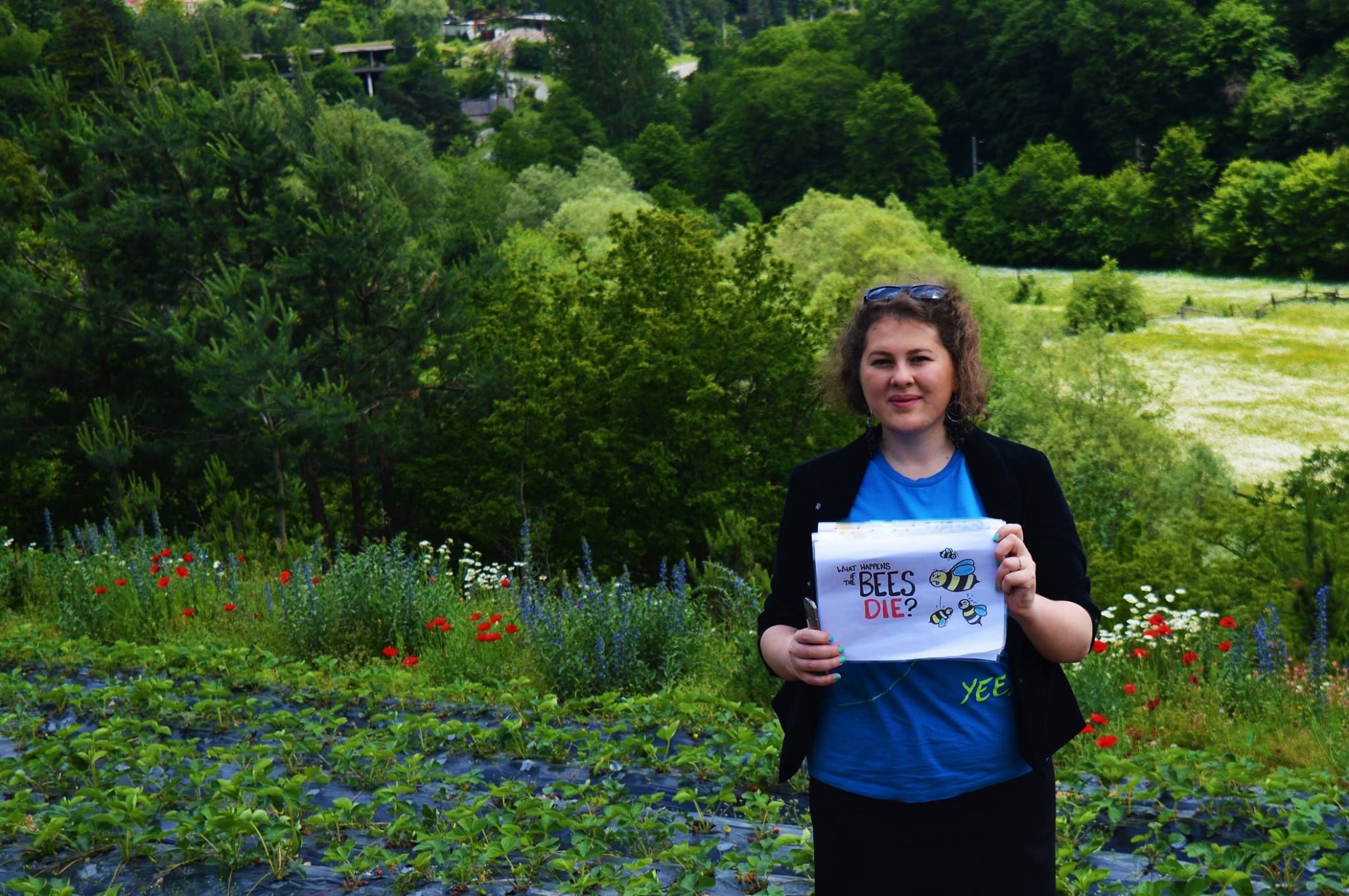 |
 |
 |
MORE ACTIVITIES FOR THE RIGHT TO BE(E) CAMPAIGN!
Even though the competition is over, there are still wonderful activities across Europe to help the bees. Read about them below!
LEARNING ABOUT HONEY AND BEEKEEPING
Who organised the activity: Ana Markovska
When it took place: June 2016
Where it took place: Novo Selo, Skopje, Macedonia
What happened: I went to visit a local producer of organic honey near Skopje and buy several jars of it. The reason for this is that by buying local-produced honey, I know what and from where I am getting the product. In addition, I also decrease the environmental impact of my consumer habits. I learned about the beekeeper in Novo Selo from a friend and during my visit, he was kind enough to answer many questions that I had, and also to show me how he makes the organic honey.
Why do you want to help the bees: The simplest answer and the most truthful is that if we don't help the bees, the world as we know will cease to exist. Bees are small yet hard-working insects that keep our eco-system together.
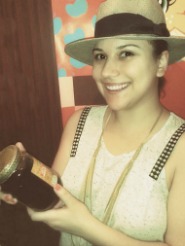 |
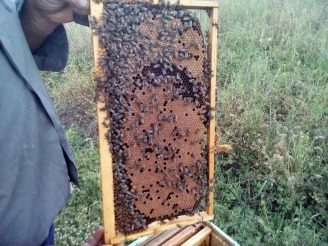 |
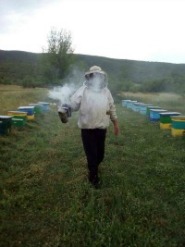 |
We prepared a few guidelines presenting examples of urban activities that you can make in order to help the bees. They are here only for your inspiration - feel free to try other ideas. Put your knowledge, creativity and concern for the bees to good use. :)
Text: Esther Vallado, Natalia Luchko, Judit Suveges, Vladimir Jordanov, Ruzanna Manyan, Jovana Mirjanić, Tijana Ljubenovic
Design: Roxana Nica
Activities guidelines available in Spanish language
 |
 |
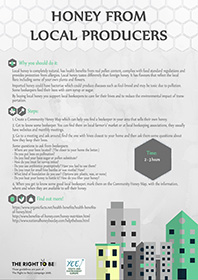 |
 |
 |
 |
 |
 In spring 2016, we planned a competition throughout Europe, encouraging people to organise actions that help the bees in urban areas. We invited all member organisations and YEE friends to take part in our campaign within their communities.
In spring 2016, we planned a competition throughout Europe, encouraging people to organise actions that help the bees in urban areas. We invited all member organisations and YEE friends to take part in our campaign within their communities.
The activities took place in April and May 2016. We collected materials from all teams, promoted them within the YEE network and included them in this year's bee competition for best activity to help the bees. The winner was EYAS and their creative Twitter campaign to promote the importance of bees. All results are shown below. Congratulations to all participants!
You can find below the activities organised by all participants within the campaign, as well as other useful materials for inspiration.
Keep buzzing!
ENTRY MODELS
Games about bees and planting action in Toulcuv Dvur
Who organised the activity: YEE office
When it took place: 22 April 2016
Where it took place: Toulcuv Dvur, Prague (Czech Republic)
What happened: On the Earth Day celebration YEE prepared a few activities for children. We had n ongoing workshop on making paper bees (which they could stick to flower pots), a game about the fruits and vegetables we can find in the garden that can be pollinated by bees, bee face painting. We also organised a planting action in the farm with the children through which we planted sunflower seeds and greenpea seeds.
Why do you want to help the bees: because they help us in so many ways and they contribute significantly to the health of our planet.
 |
 |
 |
Planting flowers in Macedonia
Who organised the activity: Vladimir Jordanov
When it took place: 17 May 2016
Where it took place: Stip, Macedonia
What happened: I planted a bee-friendly Gerbera Daisy flower in the garden of my house
Why do you want to help the bees: to have balanced and healthy ecosystems
 |
 |
 |
COMPETITION ENTRIES:
Planting flowers beside the trees on the city's sidewalk
Who organised the activity: EDEN Center
When it took place: 6 May 2016
Where it took place: Tirana, Albania
What happened: For the campaign we planted some flowers with the intention to increase the awareness regarding the bee issue by asking the interested ones to donate flowers to be planted beside the trees on the sidewalk as we did. Find out more here.
Why do you want to help the bees: we want to highlight the importance that the bees represent for the nature as well as humans; a reason why we are part on the campaign too.
 |
 |
 |
Actvities for the bees in Serbian elementary schools
Who organised the activity: Two elementary schools from Sombor, Serbia.
When it took place: 21 May 2016
Where it took place: It took place in our school, both in biology classroom and in school garden.
What happened: We talked about biodiversity and the importance of bees in human life and in nature in general. Also we talked about global problem-disappearing of bees, and thus to that we watched this video. After that we planted some flowering plants in our school garden. Also, we made few interesting magnets with bee, flower and hive motives that are now in our biology classroom, and in our homes.
Why do you want to help the bees: Importance of bees in life of all living creatures is enormous. They provide us food, they provide food to animals and reproduction to flowering plants. Without bees our life would be very different from this that we live now. So if we want to change nothing and to have various food in our plates, we need to help and protect the bees.
 |
 |
 |
Twitter campaign about the importance of bees
Who organised the activity: EYAS Young European Association for International Cooperation
When it took place: From 5th – 11th June 2016
Where it took place: Zaragoza and Madrid, Spain
What happened: We launched an online twitter campaign raising awareness about the protection of bees. It was a 7 days campaign, starting on the Environmental World Day (5thJune). We structured the campaign in 7 topics, answering with facts to these question:
Day 1: Why bees are so important?
Day 2: Why bees can disappear?
Day 3: Inspiring initiatives for the protection of bees
Day 4: What can we do for bees? Supporting this topic we planted 2 flower plants on the roofs of Madrid (photo)
Day 5: Let's share bee friendly workshop ideas
Day 6: Support your local community. Supporting this topic the team bought local honey in Zaragoza (photo)
Day 7: Spread the message!
The language used was Spanish. We reached 60 people and organizations directly, having likes and retweets JWe also mentioned organizations such @Greenpeace_Es @ONU_es and @UN to have more impact. The account for the campaign was @eyas_europe and the following hashtags were used: #RightToBee #salvemoslasabejas #SOSabejas #DMMA2016
Why do you want to help the bees: Because they balance nature and keep biodiversity.
 |
 |
 |
Having a bee-friendly garden with a wild corner
Who organized the activity? Ylona Erard
When it took place: 10th of June 2016
Where it took place: Drome, France
What happened: In the back of my garden, we have two beehives. This year I decided to let a part of the garden growing wild and it turned into beautiful wild flowers. They are really appreciated by bees and bumblebees that are buzzing all around.
Why do you want to help the bees? Because I am not sure people realize how important they are. How would be my garden without bees? How would be nature without bees?
 |
 |
|
Raising awareness on bees with online activities and meeting of beekeepers and strawberry farmers
Area Yvibisi and Daba, Georgia
We were inviting for participation every interested person to share with us their activities.They were supposed to take pictures and sent to us. We get very interesting photos from young people who shared with us their thoughts and experiences.
We visited village Kvibisi ,which is located near the Borjomi on 900 meters above sea level.There, we met one of the member of the Devidze family , they are 4-th generation beekeepers .There, in a clean environment, this family is following beekeeping and they are keeping about 100 beehives. As miss Marina told us : "Taking care of bees is a great art and consuming affair. In Devidze family, beekeeping is a tradition. My father had taught me the art of beekeeping and now I'm trying to teach it to young generations of my family and share my experience. The boys have accumulated considerable experience. Beekeeping is a practical affair and requires a lot of attention and experience gained through hard working. Scientists are often visiting us and they are completing their theoretical studies with exploring and observing our practical work. I will be happy if young people will be involved in this work and, for my part, I will share with them my experience .In my opinion in every village there should be one or two beekeeping family." Miss Marina gave us some helpful tips about beekeeping : about how important is to keep them in clean environment ,to avoid chemicals on fruits they use for food, to avoid feeding them with artificial food like sugar and etc. After rich informational conversation, we took some pictures and continued on our way to the next destination.
Near the woods is situated a cooperative of strawberry farms,where they are growing eco friendly ,clean and unpolluted strawberries and other kinds of berries. This farm was founded within United Nations Development Programme grant by Irma Maghradze .The project aims to strengthen the capacity of forest-dependent local communities, so that they can create and develop alternative livelihoods through the sustainable use of forest resources. The idea of strawberry farm was Irmas discovery, before this she had a little garden of strawberries next to her home, and she says that to be high level from the sea level is great for berries. That's why she decided to make a farm in this place.The local youngsters are actively involved in this project and they shared their impressions about thei work with excitement.
Miss Irma hosted us and shared her experience with Georgia Youth Eco Movement-SAEMs members. She invited us to see strawberry fields and she gave us to try bright red, perfectly shaped strawberries, She presented masterclass and we were talking about how pollination by the insects increases the quality and shelf life of strawberries, as the honey bees living nearby strawberries field. As we know pollination promotes cell division and growth, increasing weight and firmness of the fruit. She explained us how to take care of berries and how important is role of bees during the strawberry flowering period.
 |
 |
 |
MORE ACTIVITIES FOR THE RIGHT TO BE(E) CAMPAIGN!
Even though the competition is over, there are still wonderful activities across Europe to help the bees. Read about them below!
LEARNING ABOUT HONEY AND BEEKEEPING
Who organised the activity: Ana Markovska
When it took place: June 2016
Where it took place: Novo Selo, Skopje, Macedonia
What happened: I went to visit a local producer of organic honey near Skopje and buy several jars of it. The reason for this is that by buying local-produced honey, I know what and from where I am getting the product. In addition, I also decrease the environmental impact of my consumer habits. I learned about the beekeeper in Novo Selo from a friend and during my visit, he was kind enough to answer many questions that I had, and also to show me how he makes the organic honey.
Why do you want to help the bees: The simplest answer and the most truthful is that if we don't help the bees, the world as we know will cease to exist. Bees are small yet hard-working insects that keep our eco-system together.
 |
 |
 |
Check out:
The Right to Be(e) poster 2016
In 2015 The Right to Be(e) campaign invited everybody who supports the bees to organise a planting action.
Read here about planting events happening all over Europe!
Small rooftop garden at the ecological centre Toulcuv Dvur, Prague
Date of planting: 10 May
Who took part: YEE office
What did you plant: Vegetables (tomato, cucumber, zucchini, eggplant) and strawberries
Where did you plant it: Small urban rooftop garden at the ecological centre Toulcuv Dvur, Prague, Czech Republic
Why do you want to help bees? We are corncerned about the colony collapse disorder and we believe that everyone should come together to help bees


Zara's planting action, Yerevan, Armenia
Date of planting: 14 May 2015
Who took part: Zaruhi Stepanyan
What did you plant: Datura wrightii
Where did you plant it: In a green area near my house in Yerevan, Armenia
Why do you want to help bees? Because the bees are a very important part of our ecosystem
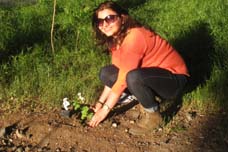

Planting action in Cluj-Napoca, Romania
Date of planting: 19 May 2015
Who took part: Cluj team - Andra, Ellie and Roxana
What did you plant: Cucumber
Where did you plant it: In a green area on the outskirts of Cluj
Why do you want to help bees? Because they play an important role in our day-to-day life. We wouldn't have all these delicious fruits and vegetables without bees.
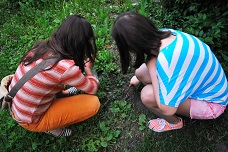

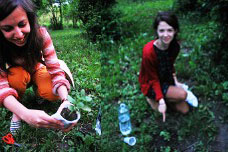
Elementary school ''Nikola Vukićević'' from Sombor, Serbia
Date of planting: 23 May 2015
Who took part: Elementary school students together with their biology teacher Ena Horvat from Sombor, Serbia
What did you plant: Lavandula angustifolia, Matricaria chamomile, Melisa officinalis, Mentha piperita, Rosmarinus officinalis, Origanum vulgare
Where did you plant it: In our school garden in Sombor, Serbia
Why do you want to help bees? Bees provides us food: fruits, vegetables, crops as well as honey, propolis and royal jelly, so we owe them so much! The least we can do is to plant a few plants and to make the city a better place for them!

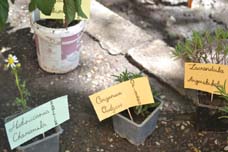
Jessica's windows box planting, London
Date of planting: 21 May 2015
Who took part: Jessica Massucco
What did you plant: Sweet pea
Where did you plant it: On the streets of East London, UK (in my window box)
Why do you want to help bees? Because they seem to be doing a good job. Also just because I love bees.


Biodiversa planting action, Asturias, Spain
Date of planting: May 23 2015
Who took part: Biodiversa NGO organized the action as part of a TC named "Connecting with Nature"
What did you plant: Lavender, thyme and rosemary
Where did you plant it: In Valeru which is a voillage in Asturias located at the north of Spain
Why do you want to help bees? Because people have the "bad habit" of eating fruits and jam and cheese and drink juices, without bees these thigs will be out of our table in short time.


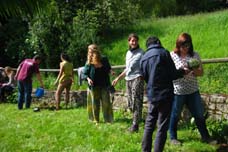
Primary school "Simeon Aranicki" from Stara Pazova, Serbia
Date of planting: 12 May 2015
Who took part: Pupils from 5 to 7 grade, as a part of our biology course in our school "Simeon Aranicki" Stara Pazova, Serbia
What did you plant: Salvia, lavandula, ocimum, tagetes
Where did you plant it: 1st step- our classrom, 2nd step- school garden
Why do you want to help bees? We are young biologists who are worried about the well-being of bees and that is why we are ofering our help.


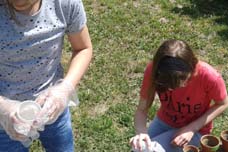
Anja's planting action in Hamburg, Germany
Date of planting: 22 May 2015
Who took part: Only me, but our whole street had a planting action this week with different kinds of flowers
What did you plant: Bell flowers (different species, 1 purple 1 white)
Where did you plant it: On my balcony
Why do you want to help bees? Especially in cities, green areas and flowers are fragmented. By planting flowers, you can support the bees in finding pollen and nectar by giving them a "green and blossoming corridor" which they can use to migrate from park to park.
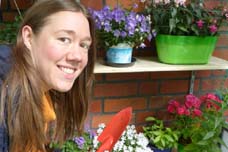
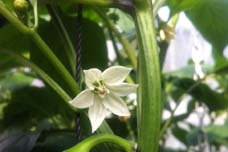
FYCA planting action, Yerevan, Armenia
Date of planting: 14 May 2015
Who took part: Office staff
What did you plant: Daisy, Forget-me-not
Where did you plant it: Near our office in Yerevan
Why do you want to help bees? Because in Armenia we are using honey too much



Ruzanna's planting action, Yerevan, Armenia
Date of planting: 21 May 2015
Who took part: Members of Yeghvard NGO, pupils
What did you plant: Dianthus, Dahlia, Petunia
Where did you plant it: School garden
Why do you want to help bees? Why not? :) Without bees biodiversity would not be so great



Elementary school "Ivo Lola Ribar" from Novi Sad, Serbia
Date of planting: 25 May 2015
Who took part: 6th grade students of elementary school "Ivo Lola Ribar" Novi Sad, Serbia
What did you plant: Rosmarinus, Melissa, Lavandula, Mentha, Thymus
Where did you plant it: School garden
Why do you want to help bees? We live in a big city, where there aren t many bees and wee all know bees are extremely useful
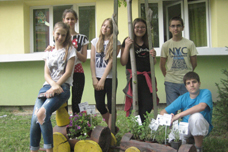


IPAS planting action in Durres, Albania
Date of planting: 27 June
Who took part: IPAS Team (Lori, Rezi and Elsiona)
What did you plant: Fidelity, Thumbergia Fragrans, Brunfelsia Grandiflora
Where did you plant it: Urban area in Durres
Why do you want to help bees? Bees give a very important contribution for human kind, providing honey, one of the most healthiest products we consume. They are an irreplaceable component of the ecosystem.

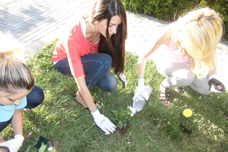
When: 11-23 May 2015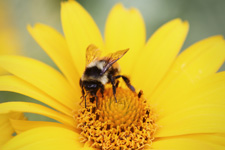
Who: everyone interested
Where: all over Europe
What: plant flowers for bees
Description:
Are you interested in supporting the survival of bees? YEE has some good news for you! For YEE's grassroots campaign "The Right to Be(e)", we want to invite all our member organisations and YEE friends to organise flower planting actions within their communities.
The events will take place between 11 and 23 May 2015. We encourage you to gather a team of bee-lovers and contribute to the creation of a better habitat for the small yellow insects.
Afterward, we will collect materials from all teams (articles, photos) and promote them within the YEE network.
Do you want to plant flowers for your local bees? Do it, fill in this template and send it with your pictures to Vladimir Jordanov This email address is being protected from spambots. You need JavaScript enabled to view it.
Keep buzzing!
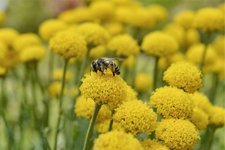 |
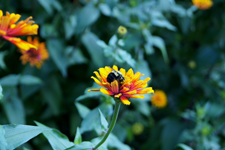 |
 |
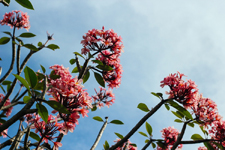 |
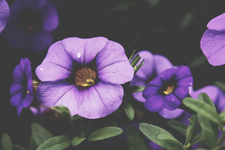 |
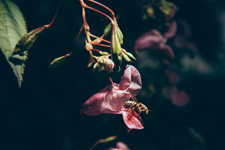 |
The Winners
The big winner of our competition was Gutta-Club from Moldova with the "Save bees" workshop. Buzzing congratulations to them! Second place went to MUDDUM with their "Sweet colours", while the third place was awarded to "The Buzzing Beehive" from Vi Odlar!. We want to congratulate all the participants for their amazing activities and to use their examples as inspiration for other bee projects.
Gutta-Club receiving the prize MUDDUM receiving the prize

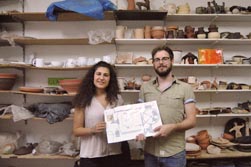
Biodiversa receiving the prize OPE receiving the prize

Mine Vaganti receiving the prize
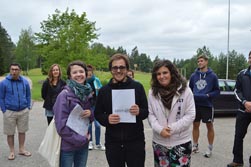
Hu2 Design has generously given us some fabulous, eco-friendly prizes. Find them on Facebook here.
 |
 |
 |
-----
Entry #1: The Buzzing Beehive
Name of the workshop: The Buzzing Beehive
Organisation: Vi Odlar! (NGO gardening group) / Lund University
Country: Sweden
Workshop description: Under the label 'The Buzzing Beehive' we set up a beehive in the cultural center Stenkrossen in Lund. With three workshops, we conducted environmental education with children aged 8-11 years from Lunds International School. The motivation for doing this project resulted from two major considerations. Firstly, people's commitment to the natural environment has decreased, particularly visible in children's knowledge and experience of nature. Secondly, the decline of bee colonies endangers ecosystem stability as well as human food supply. Our project goal was to raise children's awareness of the importance of bees. Thus, we spiked their curiosity and interest in beekeeping. By establishing the beehive together, we promoted their interest in and awareness of nature with hands-on interaction. For more information, please clilck here.
 |
 |
 |
Entry #2: Sweet colours
Name of workshop: Sweet colours
Organisation: MUDDUM
Country: Czech Republic
Workshop description: In order to learn that we can make DIY art supplies without strong chemical products, we made our own honey-based watercolours out of natural earthy pigments (sienna, ochre and black), a bit of arabic gum and local artisanal honey. Honey is used as an humectant (a substance that retains water), in our watercolours we used as the medium as well. Afterwards we used them to paint on a honeycomb grid to study its visual and structural properties.
More information can be found here.
 |
 |
 |
Entry #3: In Defense of Bees
Name of workshop: Ecoclubinos&EB1/JI Alheiras in defense of Bees
Organisation: OPE – Organização para a Promoção dos Ecoclubes
Country: Portugal
Workshop description: On February 7th, the ecoclube Ecoclubinos Gaia visited once again the school EB1/JI of Alheiras, this time taking with him a great little friend who left all the school students very happy! Our friend Bee spoke of the importance of his family to preserve the balance of ecosystems and taught the children to know and sow honey species - that help the production of honey. Each student took the challenge to grow your sunflower and help preserve our friendly honey bees that only bite us when they want to protect themselves!
 |
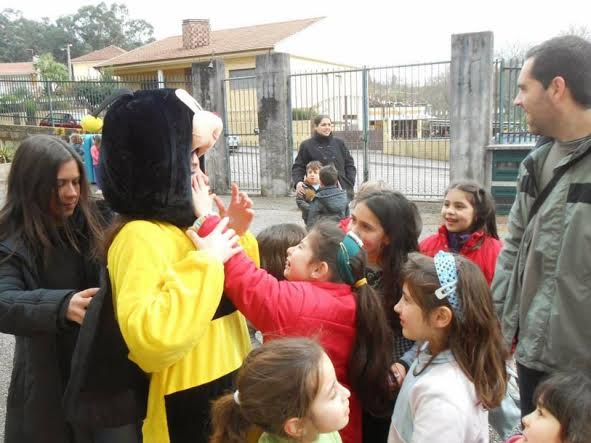 |
 |
Entry #4: 'More Than Honey' Movie Exhibition
Name of workshop: 'More Than Honey' Movie Exhibition
Organisation: OPE – Organização para a Promoção dos Ecoclubes
Country: Portugal
Workshop description: On March 8th, OPE organized a screening of the film "More than Honey", with a debate promoted by Peter, a beekeeper from the Transition Movement of Paredes. The activity occured in the auditorium of Maria Isabel Guerra Junqueiro and Luis Carvalho Pinto de Mesquita Foundation, in Porto. The projection brought together about 30 people and there was a really enriched discussion. The activity also included a demonstration of melliferous herbs.
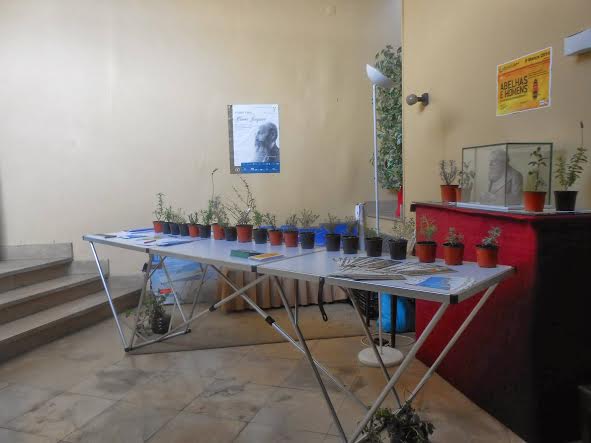 |
 |
 |
Entry #5: Regional Day for Bees
Name of workshop: Regional Day for Bees
Organisation: SVČ (Středisko volného času)
Country: Czech Republic
Workshop description: The tenth day of the regional bee - every year for the past 10 years our community has been actively involved in supporting local bees. On the regional day for bees there was lectures, competitions for both young and old citizens and an children's art contest. The judges selected the best children's art which included art for bees.
 |
 |
 |
Entry #6: Non-formal education about bees
Name of workshop: Non-formal education about bees
Organisation: Mine Vaganti
Country: Italy
Workshop description: Members of Mine Vaganti visited two local Primary Schools to lead sessions of non-formal education about the important role of the bees. Participants analized videos and proposed a creative defense action plan for the bees!
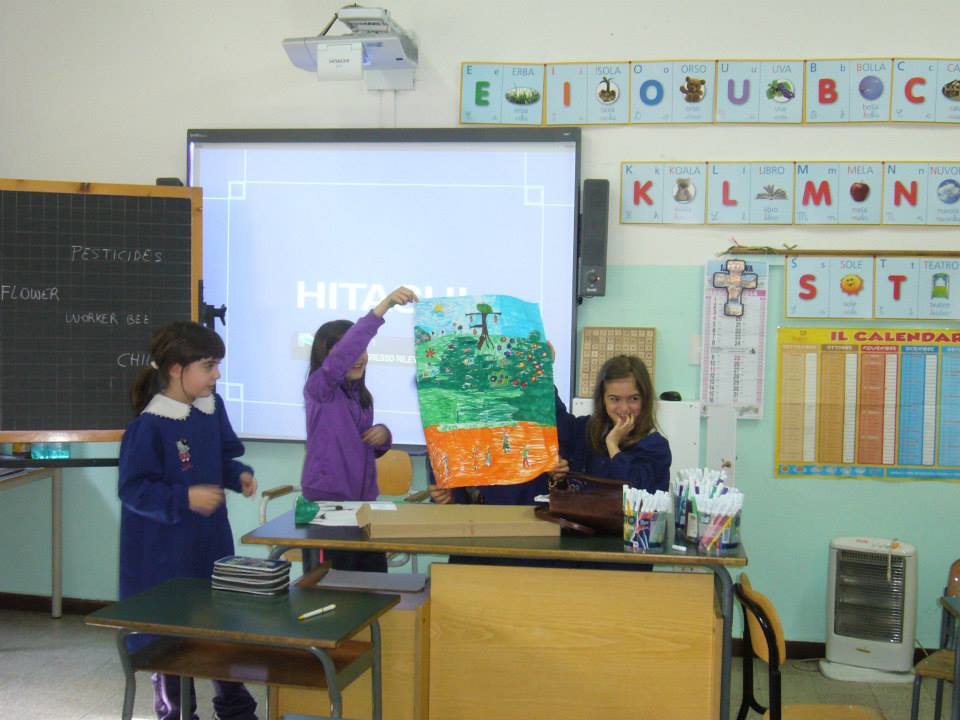 |
 |
 |
Entry #7: Think like a bee
Name of workshop: Think like a bee
Organisation: Biodiversa
Country: Spain
Workshop description: Gardens offer some of the most important habitats for bee conservation. Participants learnt how to turn any given garden into a bee-friendly garden. For this, they needed to think like a bee! Using this approach they: made a wild corner; provided shelter for the bees; planted for all the seasons; found the right flowers; created nesting sites for solitary bees; used certain plants instead of pesticides; created a bee hotel!
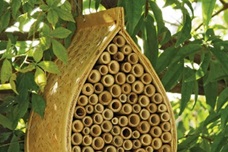 |
 |
 |
Entry #8: Save bees
Name of workshop: Save bees
Organisation: Republic Centre for Children and Youth GUTTA-CLUB
Country: Moldova
Workshop description: With our youth in action, Gutta-Club organized "Save Bees" which included a lecture about the problem itself and discussions about the importance of bees in our lives, what people can and should do to help bees survive and restore their colonies and population. Each of the participants presented a painting about bee life and bee "enemies". They made up a motto for the action "Save BEES – Save the Planet!". We made a flash-mob and spelt out Save BEES by sitting on the ground. Finally the young participants composed a fairytale about the ecological problems of the 21st century, with bees being the central characters, who with the help of the youngest generation solved all the problems and restored balance between nature and society!
 |
 |
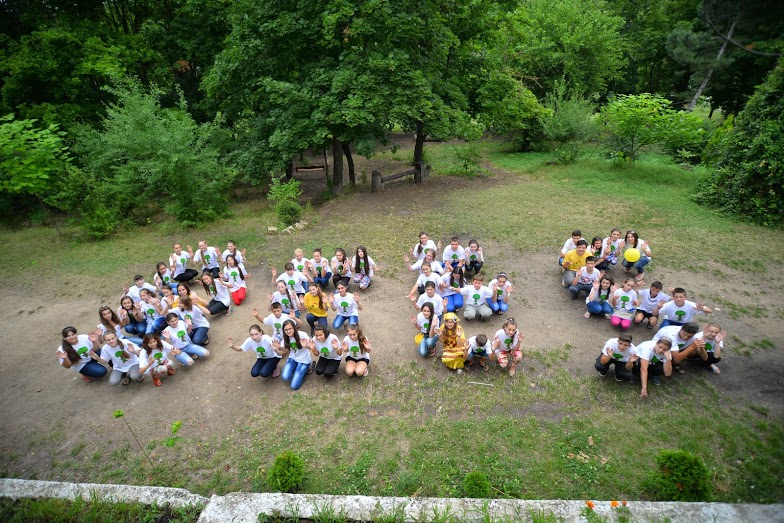 |
Check out:
The Vote:
Vote for your favourite workshop! The poll should only allow a user to vote once per device. The deadline for votes is Wednesday 30th July 2014.
Click on the link below to vote:
-----------------
Join this years competition for the best workshop about bees!
The winner will receive amazing prizes:
- €50 gift voucher for any eco wall sticker on the Hu2 Design online store.
The runners up will receive an eco wall sticker as in the picture.
 |
 |
 |
 |

How to take part:
- submit this form along with 3 photographs to Jessica at This email address is being protected from spambots. You need JavaScript enabled to view it.
The competition will be judged by public vote.
You can use our workshop guides or come up with your own idea! Anyone is welcome to enter.
Deadline for submissions: Friday 18 July 2014
If you choose to try some guerrilla gardening, it is very important that you pick a safe but neglected area of public land. You do not want to get into trouble for trespassing on private land. Check your country's legal position on guerrilla gardening now. Attitudes vary across Europe.
"The kind of guerrilla gardening that I advocate is mostly public land that is neglected. To me this is a fantastic resource for us all. This is our land. It's public already and if it isn't being looked after, if it's been forgotten about or abused, or attracting anti-social behaviour then imagine what it could be instead."
Richard Reynolds, TED Talk (watch here)
You will need to check the area for broken glass and dangerous waste first. Be aware of busy roads and your personal safety.
Think small: Plant in all the small, grey corners of your city. Some poppies by the bus stop... lettuce on the street corner... sunflowers by the recycling bins. A lot of small actions will green the city! You do not have to take big risks.
Some ideas:
Window sills
Doorsteps
Hanging baskets
Terraces
Rooftops
Public areas:
Read our Guerrilla Gardening Guide!
External Links:
Guerrilla Gardening from Italy (in English)
Guerrilla Gardening: Getting Started
Guerrila Gardening Books by Richard Reynolds
Pinterest Tag: Guerrilla Gardening
Environmental Graffiti Article
Videos:
How to make Seed Bombs by Beepkeeping College of the Melissae
These guides will give you step-by-step instructions on how to organise your own workshops. Each one will help support the survival of bees.
Text: Jessica Massucco, Jesus de la Hoz, Ines Cilka, Lira Hakani
Design and Photography: Jessica Massucco
|
Organic Food Tasting |
Urban Gardening |
Guerrilla Gardening |
|
Puppet Theatre for Bees |
Urban Beekeeping |
|
How to get Free Seeds How to promote your event
Materials:
Puppet Theatre for Bees: Script
Puppet Theatre of Bees Puppets:
Urban Beekeeping: Example Letter to Beekeeper
Guerrilla Gardening: Inspiration
Guerrilla Gardening: Where to plant
Urban Gardening: Where to put plants
Urban Gardening: Campaign Slogans
Follow the news about planting actions here and get inspired.
"Vanishing of the Bees" movie screening

If you like bees, you can also organise an event to raise awareness about the problem of our small friends!
Spontaneous Plantings across Europe
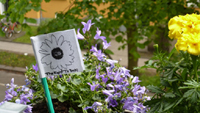 YEE members continue to make small planting actions across Europe to support the survival of bees. Every action makes a difference! Here's a photo of The Right to Be(e)'s flag flying proudly in the garden.
YEE members continue to make small planting actions across Europe to support the survival of bees. Every action makes a difference! Here's a photo of The Right to Be(e)'s flag flying proudly in the garden.
Family Planting in Walmsburg, Germany
 On a beautiful sunny day in April 2013 I had a small planting action in the little village Walmsburg. Two of my brothers, my mother and I, planted some bee-flowers at the edge of our farm. We sowed Lacy Facelia, Calendula and Malva in the ground. We gave them water and now we are looking every day after them and hoping that they will grow up and bloom in a few month and give nectar to the bees.
On a beautiful sunny day in April 2013 I had a small planting action in the little village Walmsburg. Two of my brothers, my mother and I, planted some bee-flowers at the edge of our farm. We sowed Lacy Facelia, Calendula and Malva in the ground. We gave them water and now we are looking every day after them and hoping that they will grow up and bloom in a few month and give nectar to the bees.
Iolanthe Kappe
Earth Day: Bee Info and Planting workshop in Prague, Czech Republic
 On 20 April 2013 the YEE team took part in the Earth Day celebrations on Toulcuv Dvur. We organised an informational stand with interesting games, facts and cartoons about bees. We also painted small bees on our faces and everyone who wanted to have one too.
On 20 April 2013 the YEE team took part in the Earth Day celebrations on Toulcuv Dvur. We organised an informational stand with interesting games, facts and cartoons about bees. We also painted small bees on our faces and everyone who wanted to have one too.
The highlight of our day was sowing the seeds of Lacy phacelia (or Svazenka vraticolista in Czech). These flowers are favourites among local bees who like to pollinate them and produce tasty honey. The planting was very easy and a lot of fun: we just took handfuls of seeds and scattered them around the small field on the farm. Then we only had to work a bit with a rake and hope that the seeds will stay in the soil and grow to be nice purple flowers.
See the photogallery here.
There is so much about bees on the internet. Take your time and find out more about them!
News and articles about bees:
Bee deaths: EU delays action on pesticides ban
Pesticide makes bees forget the scent for food, new study finds
Neonicotinoid pesticides 'damage brains of bees'
British Beekeepers Assosiation
Bee venim can kill HIV, study says
How you can prevent the collapse of the BEE-cosystem
10 days for a pesticide-free spring!
European agriculture at risk: time to ban bee-killing pesticides
Movies and videos about bees:
Green infrastructure – Building blocks of modern life
Vanishing of the Bees (official website)
More than Honey (official website)
Every city nees healthy honey bees (TED talk)
Gardening tips
 The Right to Be(e) campaign aims to support the survival of bees.
The Right to Be(e) campaign aims to support the survival of bees.
It was created in 2012 to attract more attention to the disappearance and well-being of bees in Europe. Its first activities started in 2013, when YEE encouraged people across Europe to plant bee-friendly flowers in a planting flashmob on Earth Day.
This year we will continue with the campaign. You can find out more information about The Right to Be(e) campaign 2017 here. Anyone and everyone is welcome to join! It is a perfect example of the philosophy: Think Globally, Act Locally.
What you can do to help the bees:
- Organise local planting actions
- Green up your cities
- Spread news about bees in your local communities
- Support local beekeepers
- Campaign against pesticides
- Rejoice in your love for bees!
![]() Join the community on Facebook
Join the community on Facebook
Keep the planet buzzing. Donations will be spent on bee workshops in Prague, YEE's headquarters.
We are recruiting bee campaigners to make a local actions in their own communities! We are creating interactive workshop guides for our campaigners. Sign up here!
MATERIALS:
Funders:
 |
 |
 |




